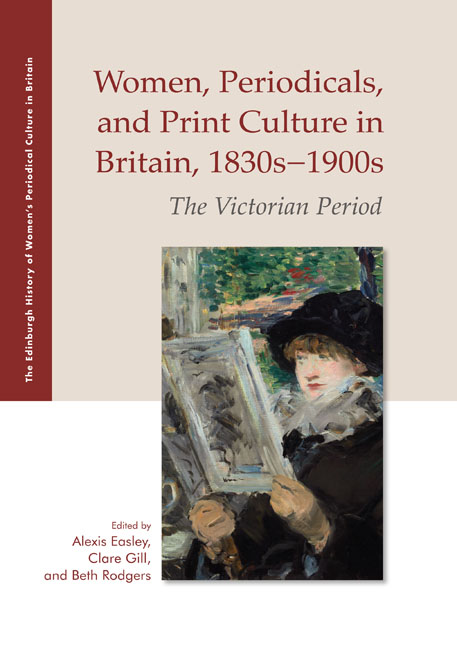Book contents
- Frontmatter
- Contents
- List of Illustrations
- Acknowledgments
- Introduction: Women, Periodicals, and Print Culture in the Victorian Period
- Part I (Re)Imagining Domestic Life
- Part II Constructing Modern Girls and Young Women
- Part III Women and Visual Culture
- Part IV Making Space for Women
- Part V Constructing Women Readers and Writers
- Part VI Intervening in Political Debates
- Notes on Contributors
- Index
- Plate section
Introduction: Women, Periodicals, and Print Culture in the Victorian Period
Published online by Cambridge University Press: 25 October 2019
- Frontmatter
- Contents
- List of Illustrations
- Acknowledgments
- Introduction: Women, Periodicals, and Print Culture in the Victorian Period
- Part I (Re)Imagining Domestic Life
- Part II Constructing Modern Girls and Young Women
- Part III Women and Visual Culture
- Part IV Making Space for Women
- Part V Constructing Women Readers and Writers
- Part VI Intervening in Political Debates
- Notes on Contributors
- Index
- Plate section
Summary
‘Politics are our habitual study, Joe. Do you know I see a newspaper every day, and two of a Sunday?
’ ‘I should think you'll read the marriages, probably, miss, and the murders, and the accidents, and sich like?’
‘I read the leading articles, Joe, and the foreign intelligence, and I look over the market prices. In short, I read just what gentlemen read.’ (Charlotte Brontë, Shirley, 1849: 245)
THE EPONYMOUS HEROINE of Charlotte Brontë's novel Shirley (1849) was not untypical in her appetite for newspapers. The Victorian press, in all its myriad mutations, formed the bedrock of the cultural diet of many, if not most, women readers, including Brontë herself. Like her fictional creation, Brontë was a serious reader of newspapers, as well as of selected magazines and journals, reading the same paid-for and borrowed periodicals as her father, brother, and sisters. As the thirteen-year-old Brontë noted in her diary in 1829, ‘We take two and see three newspapers a week. We take the “Leeds Intelligencer,” Tory, and the “Leeds Mercury,” Whig, edited by Mr Baines, and his brother, son-in-law, and his two sons, Edward and Talbot. We see the “John Bull;” it is a high Tory, very violent. Mr Driver lends us it, as likewise “Blackwood's Magazine,” the most able periodical there is’ (Gaskell 1985: 116–17). Her detailed knowledge of the editors of and contributors to the newspapers and magazines that she and her family read regularly is evidence of the extent to which Brontë consciously immersed herself in the periodical culture of the day. The shaping effect of this dedicated programme of serial reading can be detected clearly in her novels, as the epigraph from Shirley indicates. In The Common Reader, Virginia Woolf also notes the palimpsestic trace of Victorian journalism in Brontë's prose, but locates her ability to transcend its stylistic limitations in order to create pure poetry in her novels as constituting part of her greatness as a writer (1948: 199–200).
Woolf's rejection of the cultural value of Victorian journalistic style would have been anathema to the young Charlotte Brontë, whose reverence for certain periodicals, and for Blackwood's Edinburgh Magazine (1817–1980) in particular, led her to privately produce a magazine of her own.
- Type
- Chapter
- Information
- Women, Periodicals and Print Culture in Britain, 1830s–1900sThe Victorian Period, pp. 1 - 12Publisher: Edinburgh University PressPrint publication year: 2019

